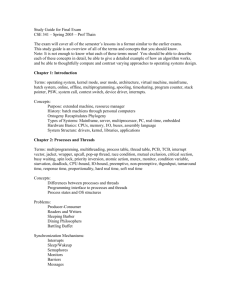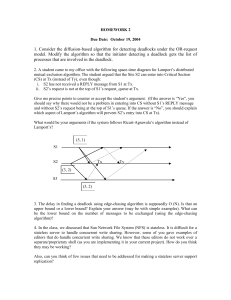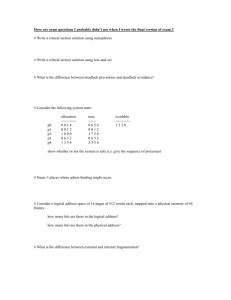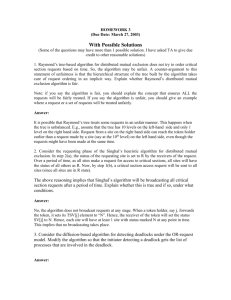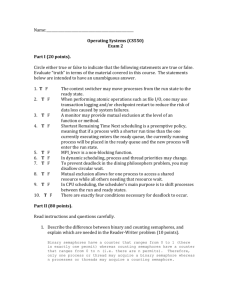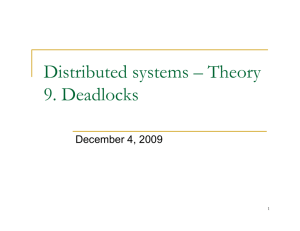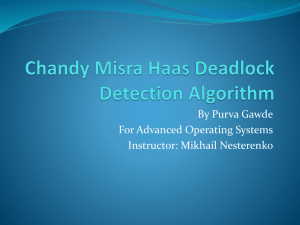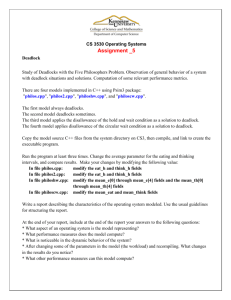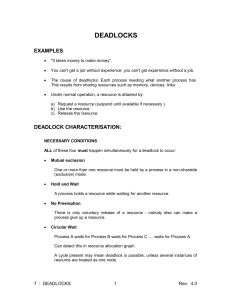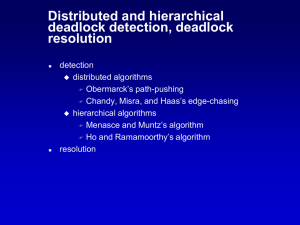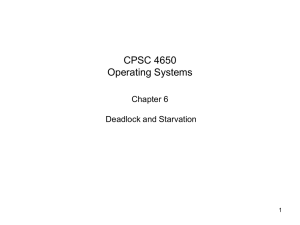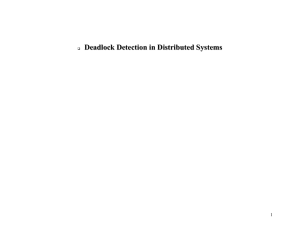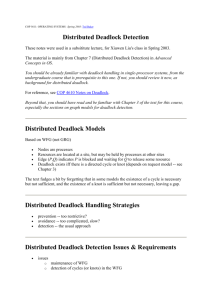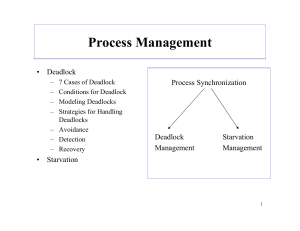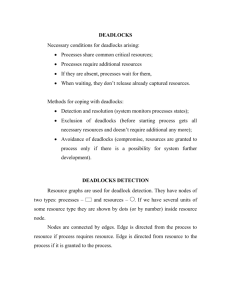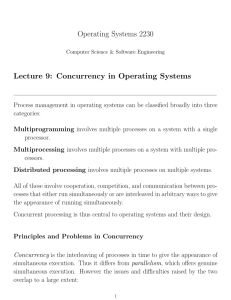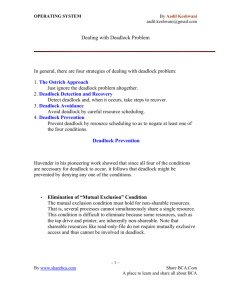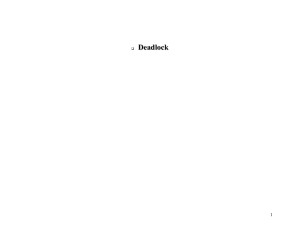1) 6.23-6.24 Write a bounded-buffer monitor in which the buffers
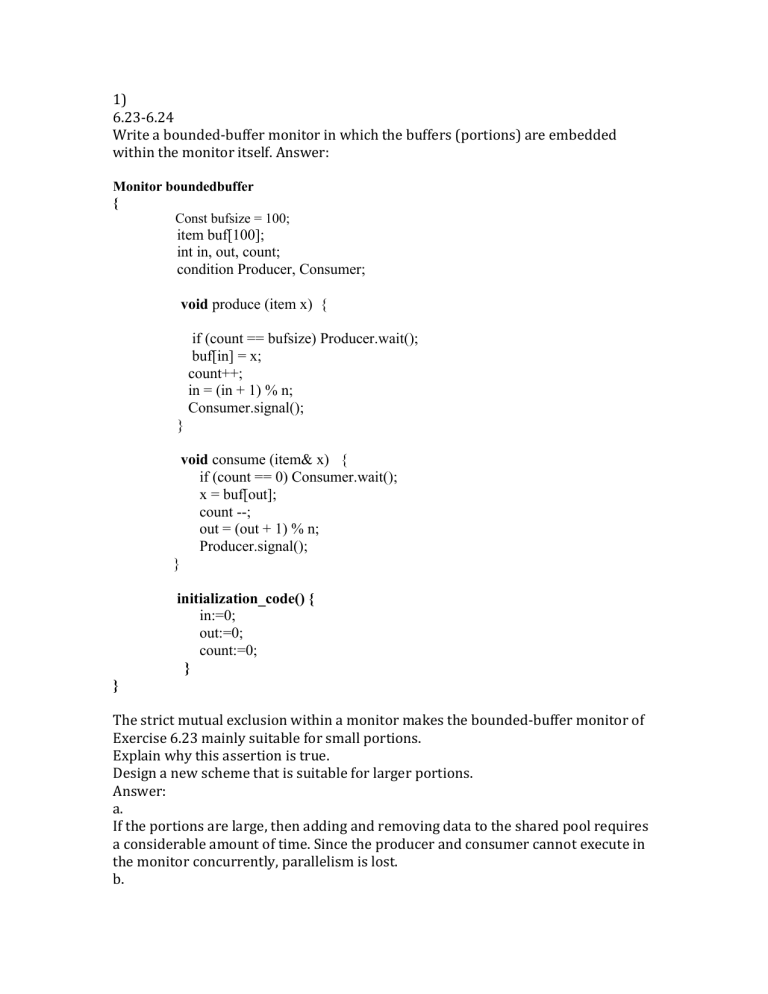
1)
6.23-6.24
Write a bounded-buffer monitor in which the buffers (portions) are embedded within the monitor itself. Answer:
Monitor boundedbuffer
{
Const bufsize = 100; item buf[100];
int in, out, count;
condition Producer, Consumer; void produce (item x) {
if (count == bufsize) Producer.wait();
buf[in] = x;
count++;
in = (in + 1) % n;
Consumer.signal();
} void consume (item& x) { if (count == 0) Consumer.wait();
x = buf[out];
count --;
out = (out + 1) % n;
Producer.signal();
}
initialization_code() {
in:=0;
out:=0;
count:=0;
}
}
The strict mutual exclusion within a monitor makes the bounded-buffer monitor of
Exercise 6.23 mainly suitable for small portions.
Explain why this assertion is true.
Design a new scheme that is suitable for larger portions.
Answer: a.
If the portions are large, then adding and removing data to the shared pool requires a considerable amount of time. Since the producer and consumer cannot execute in the monitor concurrently, parallelism is lost. b.
No Answer
6.33 in a multi processor system the busy waiting is offloaded to the other cpu and primary functions aren’t hindered. On a single processor system spinlocks introduce a lot of busy waiting and wast processor cycles.
6.37
A) available resources is the date in the race condition
B) P273
C) int decrease_count(int count)
{ if (available_resources<count) return -1 else for(int i=0; i<count; i++) wait(available_resources); return 0;
} int increase_count(int count)
{ for(int i=0; i<count; i++) signal(available resources); return 0;
}
7.9
Yes it is possible to have a deadlock using only a single process. Should it require access to a resource it locked previously but didn’t meet the requirements to unlock a deadlock will be experienced.
Is it possible to have a deadlock involving only one single process? Explain your answer. Answer: No. This follows directly from the hold-and-wait condition.
People have said that proper spooling would eliminate deadlocks. Certainly, it eliminates from contention card readers, plotters, printers, and so on. It is even possible to spool tapes (called staging them), which would leave the resources of
CPU time, memory, and disk space. Is it possible to have a deadlock involving these resources? If it is, how could such a deadlock occur? If it is not, why not? What deadlock scheme would seem best to eliminate these deadlocks (if any are possible), or what condition is violated (if they are not possible)? Answer: It is possible to still have a deadlock. Process P1 holds memory pages that are required by process P2 , while P2 is holding the CPU that is required by P1.The best way to eliminate these types of deadlock is to use preemption.
7.16 a) The max need is between 1 & m inorder to insure that a process doesn’t require more resources than actually exist. b) The sum of all max needs is less than m + n. if not you run the risk of waiting for resources that wont be released. For example you have 2 resources and 2 process and each have a max need of two. If each takes 1 they will forever wait for the other to realesas the resouce which it wont do till it gets 2 total.
7.20 allocation
0 0 1 2
1
1
0
0
Max
0
1
2
0
0
Available
1
A)
Need (max-allocation)
0
0
1
0
7
3
6
6
0
3
6
0
5
1
5
5
5
5
0
5
3
1
2
2
0
6
2
6
0
4
2
4
0
0
7
0
0
5
0
0
0
2
0
0
0
6
2
4
0
2
B)
There is a sequence that each process can take to complete max so yes in safe state.
C)
The request can be filled since there is enough available resources. 0,4,2,0
7.22
North
{ wait(bridge)
{ cross() signal()
South
{ wait(bridge)
} cross() signal()
7.23
North
{
Signal(south) wait(bridge)
{ cross() signal()
South
{ signal(north) wait(bridge) cross()
} signal()
8.10 a) b) the object modules and the location of the other needed object modules are reuired to be passed to the linkage editor in order for it to be able to properly link the program.
8.18
I can’t figure out how these numbers are derived
8.4
Consider a logical address space of eight pages of 1024 words each, mapped onto a physical memory of 32 frames.
a. How many bits are there in the logical address?
b. How many bits are there in the physical address?
Answer:
a. Logical address: 13 bits b. Physical address: 15 bits
8.22
Reentrant code works best with segmentation because is treats each part of the code as its own separate element and makes accessing the shared parts of the code easy to follow from a programming point of view. Strait paging does everything automatically and give the programmer no control over what is done and how its stored in memory.
8.25
3 memory operations are performed retrieve section, retrieve page, and retrieve data at offset. Retreive the pate table entry for the page table entry. Need to retrieve page table entry for the frame where the data is. Get data
9.3
Demand paging
Good
Stack – resides in memory and as things are required they are recovered from the secondary memory and added to the stack as necessary.
Hashed Symbol table – This will keep things out of memory until they are required.
Binary search – will be able to go through on a needed bases and unsearched values need not be loaded to memory.
Pure code – good because the code is already divided into parts and those parts only need to be loaded as needed.
Not good
Sequential Search - this will result in an excessive amount of page faults and greatly slow the system.
????????
Vector operations – array multiplication
Indirection – usage of lots of pointers
9.7 a. The page reference string is
0, 1, 0, 2, 0, ..., 0, 49, 0, 1, 0, 2, 0, ..., 0, 49, ... and thus there will be 5000 page faults. b. The page reference string is
0, 1, 0, 2, 0, ..., 0, 49
and thus there will be 50 page faults.
9.12 a the processes are just starting to rev up and a lot of paging is going on inorder to load the code into the cpu “thrashing b all the needed code has been paged and the cpu is actively running all the processes could increase thorugh increased multiprogramming is this right?
C
The processes have done most of the heave work and things have slowed down for both the cpu and I/O usage. Increasing multiprogramming will increase utilization.
2]
The program fragment below is a monitor. Rewrite it using the CCR construct. monitor Simple; var C : condition;
count: integer; procedure Alternate; begin
count := count + 1;
if (count mod 2) = 0 then C.wait
else C.signal; end; begin count := 0; end.
Using_CCR(simple)
{ count++; region simple when (count %2 ==0) do
C.wait
Region simple do
C.signal
}
3]
Deadlocks can be detected, avoided or prevented. Comment on the following statements: (i.e. state if they are correct or wrong and why).
* Deadlock detection is more general than deadlock prevention or deadlock avoidance.
False – requires more overhead that includes not only the runt time costs of maintinaing the necessary info and executing the the detection algorithm but also the potential losses inherent in recovering from a deadlock.
* It is better to prevent deadlocks than to detect them.
* If a deadlock is detected, we can use a deadlock avoidance technique to prevent the deadlock.
* A cycle in a resource-allocation graph is an early warning signal of possible future deadlock.
True - cycles are an essential part of dead locks
* A cycle in a waits-for graph is an early warning signal of possible future deadlock.
* The Bankers algorithm ensures that there is no cycle in the Resource allocation graph.
True because it wont release resources into an unsafe state
* If there is a deadlock, there must be a cycle in the resource allocation graph.
True because a cycle implys interdependency between resources and processes. If there is no interdependency there can be no deadlocks. This is what it means to have circular waiting.
4]
Some operating systems use base and bound registers to protect memory. The bounds registers updated (or changed)
When?
Why?
By whom?
5]
Swapping is a method of increasing the capacity of the main memory. Note that swapping is not the same as demand paging.
* When is a process swapped in?
* When is a process swapped out?
* Does a whole process have to be in memory before it can be run? Why?
6]
Consider a demand paged system using "lazy" or "pure" demand paging.
* What is "lazy/pure" demand paging?
* What are the factors that limit the MAXIMUM amount of memory that can be allocated to 1 process?
* What are the factors that limit the MAXIMUM amount of memory that can be allocated to all the processes (total)?
* What are the factors that determine the page fault rate?
7]
The virtual memory system using demand paging, also provides memory protection.
* Explain clearly (and briefly) how is protection achieved.
* Show how the paging system determines when a page reference is an illegal page or a page not currently in memory.
8]
Show that the " Optimal Page Replacement Policy (OPT)" is indeed optimal, that is there is no algorithm, known or unknown that can perform better than the OPT policy.
9]
A method of deadlock prevention is the use of ordered resource allocation.
Does this scheme work when there are multiple instances of each resource?
Justify your answer.
10]
The device driver for disk devices is used to read and write blocks of data to and from disk units.
* Why is the driver split into two "halves" and what are these two halves?
* Where in the driver is the disk scheduling policy implemented?
* If the page replacement policy is FIFO, should the disk scheduling policy also be
FIFO? Why or why not?
* Which policy is better at minimizing disk head movement: SSTF or LOOK?

